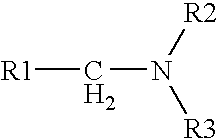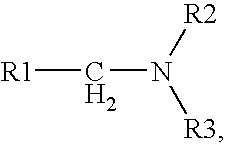Process for obtaining amines by reduction of amides
a technology of amide and amide, which is applied in the field of improving the process of obtaining amines, can solve the problems of reducing the alcohol content of the product, forming undesired dialkylamines, and not being able to use a hydrogen amount which would vaporise all of the amide, and achieves low operation pressure, reduce construction costs, and simple process follow-up.
- Summary
- Abstract
- Description
- Claims
- Application Information
AI Technical Summary
Benefits of technology
Problems solved by technology
Method used
Image
Examples
example 1
[0042] In a fixed bed reactor containing 15 g of CuCr catalyst (Leuna 1970T) a mixture of N,N-dimethyldecylamide, DMA and H2 is introduced. The mixture with a molar composition of amide / auxiliary amine / H2 of 1 / 3 / 120 is preheated and introduced continuously at the catalyst bed at a rate of 15 g amide / h. The reactor is heated at 250° C. and operated at 10 bars. At the outlet, the product containing the amine is separated from the gas by condensation. The liquid outlet is analysed using gaschromatography, the composition (area%) is displayed in table 1. By a simple methylation reaction, N-methyldecylamine can be converted to N,N-dimethyidecylamine reducing the side products to less than 1%.
TABLE 1product distribution (GC analysis, area %)N,N-N,N-dimethylN-methylN-methyldimethyldecylaminedecylaminedidecylaminedecylamideDecanol96.32.70.7Nd0.1
Nd: not detected
example 2
[0043] In a fixed bed reactor containing 50 g of CuCr catalyst (Cu0203 Engelhard) a mixture of N,N-dimethyldodecyl amide, DMA and H2 with following molar ratio 1 / 3 / 76 is fed continuously at an amide rate of 20 g / h. Prior to the catalyst bed, the mixture passes a pre-heater at 250° C. The catalyst bed is also heated at 250° C. and the reactor is operated at 5 bars. At the outlet, the product containing the amine is separated from the gas flow (containing the H2 and the auxiliary amine) by condensation. The liquid outlet is analysed daily using gaschromatography, the composition (area %) is displayed in table 2. No deactivation is observed after 1 month of testing.
TABLE 2product distribution (Gc analysis, area %)N,N-dimethylN-methylN,N-dimethylDaydodecylamineN-methyl dodecylaminedidodecylaminedodecylamidedodecanol 197.61.80.6NdNd1097.61.80.5NdNd3097.51.80.6NdNd
Nd: not detected
example 3
[0044] In a fixed bed reactor containing 5 g of catalyst (Cu0203 Engelhard) a mixture of N,N-dimethylacetamide, DMA and H2 is introduced. The mixture with a molar composition of amide / auxiliary amine / H2 of 1 / 3 / 30 is preheated and introduced continuously at the catalyst bed at a rate of 2 g amide / h. The reactor is heated at 250° C. and operated at 10 bars. At the outlet, the product containing the desired amine is analysed with GC on-line. The product composition (area %) is displayed in table 3
TABLE 3product distribution (GC analysis, area %)N,N-N,N-dimethylN-methylN-methyldimethylethylamineethylaminediethylamineacetamideethanol96.12.80.8NdNd
Nd: not detected
PUM
| Property | Measurement | Unit |
|---|---|---|
| Pressure | aaaaa | aaaaa |
| Pressure | aaaaa | aaaaa |
| Pressure | aaaaa | aaaaa |
Abstract
Description
Claims
Application Information
 Login to View More
Login to View More - R&D
- Intellectual Property
- Life Sciences
- Materials
- Tech Scout
- Unparalleled Data Quality
- Higher Quality Content
- 60% Fewer Hallucinations
Browse by: Latest US Patents, China's latest patents, Technical Efficacy Thesaurus, Application Domain, Technology Topic, Popular Technical Reports.
© 2025 PatSnap. All rights reserved.Legal|Privacy policy|Modern Slavery Act Transparency Statement|Sitemap|About US| Contact US: help@patsnap.com



